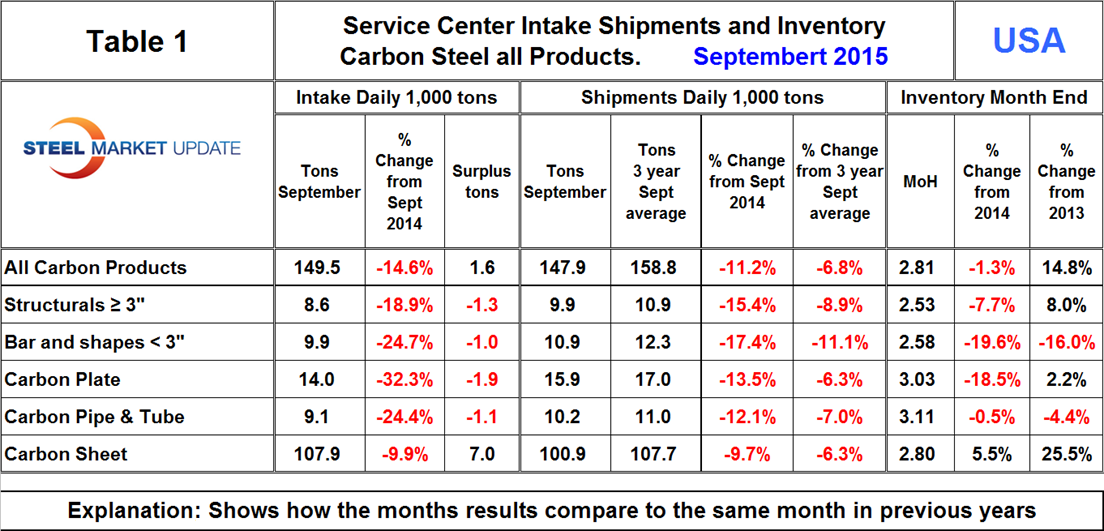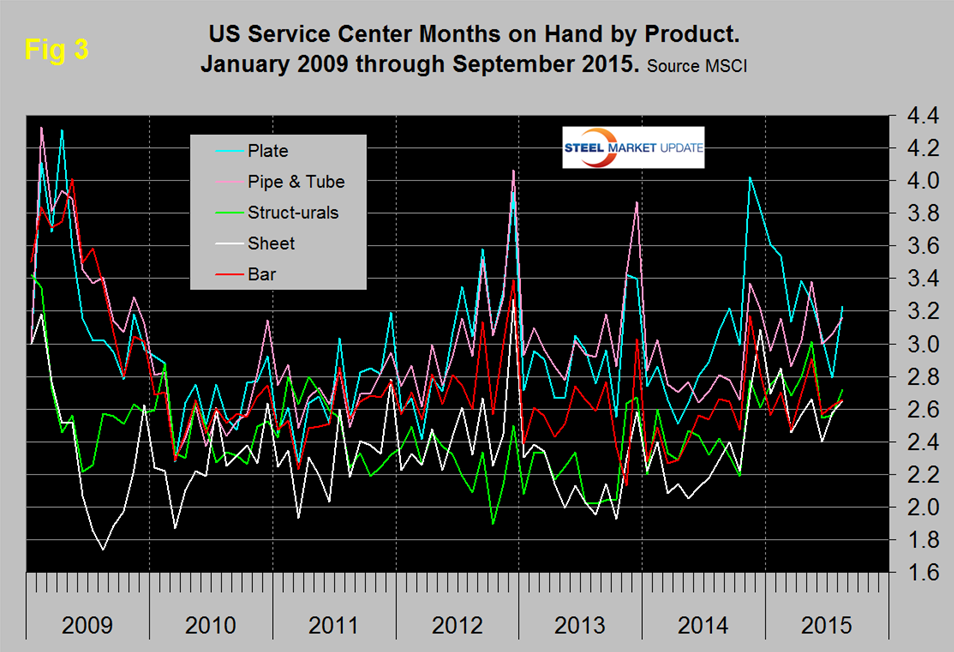Steel Mills

Service Center Intake, Shipments and Inventory through September 2015
Written by Peter Wright
October 19, 2015
Based on Steel Market Update (SMU) analysis of the recently released MSCI service center inventory and shipment data, total service center carbon steel shipments decreased by 55,000 tons in September to 3.105 million tons. Shipping days at 21, were unchanged from August. On a tons per day basis (t/d) shipments decreased from 150,500 tons in August to 147,900 tons in September.
![]()
In the twelve years since 2004 September shipments on average have been up by 0.4 percent from August, this year shipments were down by 1.7 percent. Therefore on a long term basis (12 years) the September performance compared to August was worse than normal. This observation is only intended to give a long term perspective because MSCI data is extremely seasonal and we need to get past that before commenting in detail on current results. Figure 1 demonstrates this seasonality and why comparing a month’s performance with the previous month is usually misleading.
We are now entering a period when shipments in t/d will decrease for three straight months before bouncing back in January. In the SMU analysis we always consider year over year changes to eliminate seasonality. Table 1 shows the performance by product in September compared to the same month last year and also with the average t/d for September in the last three years. We then calculate the percent change between September 2015 and September 2014 and with the 3 year September average. We hope this gives an undistorted view of market direction.
In September intake at 149,500 tons was 1,600 tons more than shipments. This was the third month of surplus intake following five straight months of deficit. The intake surplus was driven entirely by sheet products for which the surplus was 7,000 tons, all other products had an intake deficit. Compared to last September, intake was down by 14.6 percent overall and all product groups except sheet were down by double digits.
Shipments of all products on a t/d basis were down by 11.2 percent from September last year and were 6.8 percent less than the average September shipments for 2015, 2014 and 2013. The fact that the single month y/y growth comparison is worse than the three year comparison is an indication that momentum is negative and the contraction is accelerating. Figure 2 shows the long term trends of daily shipments and month end inventory since 1995.
Daily shipments had a post recessionary high of 173,300 in April last year and have had a downward trend ever since. In September shipments of all products except sheet were down by double digits year over year, sheet was down by 9.7 percent. Shipments of long products had the highest rate of growth contraction.
September closed with months on hand (MoH) of 2.81, up from 2.75 at the end of August and up for the 3rd consecutive month. All products except sheet had a y/y increase in MoH. Figure 3 shows the MoH by product monthly since January 2009. Plate has had a particularly strong inventory decline since the end of last year but bounced back in August and September.
There continues to be a wide difference between the performances of flat rolled (sheet + plate) and long products (structurals + bar) at the service center level. Long products have had a very poor recovery from the recession. On a 3MMA basis y/y, the growth of shipments was negative for 21 straight months until April last year which was the first of eleven months of growth. However in March on a y/y basis shipment growth returned to negative territory at -2.6 percent followed by April at -7.6 percent, May at -11.6 percent, June at -13.5, July at -13.5 percent, August at -13.9 percent, and September at -15.4 percent (Figure 4).
Considering the improving construction statistics, we have no explanation for this recent dismal and deteriorating long product performance. Flat rolled has had a much better recovery since mid-2009 and had positive y/y growth for 18 straight months through January this year. In February growth slowed to zero, in March came in at negative 1.6 percent followed by April at -6.6 percent, May at -8.3 percent, June at -9.1 percent, July at -6.6 percent, August at -7.0 percent and September at -8.1 percent (Figure 5).
In 2006 and 2007, the mills and service centers were operating at maximum capacity. Figure 6 takes the shipments by product since that time frame and indexes them to the average for 2006 and 2007 in order to measure the extent to which service center shipments of each product have recovered.
Again it can be seen that bar and structurals have the worst record. Sheet and plate have had the best recovery since the recession followed by tubulars. Even so the recovery of sheet is only at 77.1 percent and plate at 75.7 percent. The total of carbon steel products is now at 69.7 percent of the shipping rate that existed in 2006 and 2007, with structurals and bar at 55.8 percent and 54.2 percent respectively.
MSCI uses product nomenclature flat and plate. In this analysis at SMU we replace the term flat with sheet. By our interpretation of the MSCI’s data their definition of “flat” is all hot rolled, cold rolled and coated sheet products. Since most of our readers are sheet oriented we have removed plate from Figure 5 to highlight the history of sheet products which are shown in (Figure 7).
Following the strong post-recession recovery, sheet products experienced 9 months of decline from October 2012 through June 2013. This was followed by eighteen months of growth through January this year but February slipped back into negative territory at -0.7 percent year over year, the March result was -2.3 percent followed by April at -7.3 percent, May at -9.1 percent, June at -9.8 percent, July at -7.6 percent, August at -7.2 percent and September at -7.9 percent.
SMU Comment: This report is ugly. Intake and shipments are down on all products from September last year with sheet being down the least. Inventories in terms of MoH were also down y/y in September for all products except sheet which was up by 5.5 percent. Figures 2, 4, 5 and 7 show that there has been a distinctly negative decline in shipments for all products since the middle of last year. This MSCI data is now diverging from our report of total supply to the market which is based on AISI shipment and import data. Total supply of hot rolled products peaked in October last year and since January hasn’t changed much as shown in Figure 8.
As stated above, service center shipments have been in continuous decline since April last year.
The SMU data base contains many more product specific charts than can be shown in this brief review. For each product we have ten year charts for shipments, intake, inventory tonnage and months on hand. Some readers have requested these extra charts for a particular product and others are welcome to do so.

Peter Wright
Read more from Peter WrightLatest in Steel Mills

AISI: Raw steel production drops to multi-month low
After being historically strong for more than four months, US raw steel production fell for a second week.

U.S. Steel sues Algoma over iron pellet shipments
U.S. Steel is suing Algoma over the Canadian flat-rolled producer's rejection of iron pellet shipments, arguing it has breached its contract.

August US mill shipments slip but still higher than last year
The American Iron and Steel Institute reported a decline in the monthly shipments of US mills from July to August.

TransPod, Algoma, Supreme Steel linkup anchors Canadian steel in high-speed transit build
The three Canadian companies have announced a strategic partnership to support the development of an ultra-high-speed transit line from Edmonton to Calgary.

Metallus, USW agree to tentative four-year labor deal
Metallus and the United Steelworkers (USW) have agreed to a tentative four-year labor contract.









